Reloading (or hand loading) your own ammunition has a number of benefits. The two biggest upsides that we have found are:
- The cost – you are essentially recycling your ammunition.
- The accuracy – factory rounds can vary in quality whereas hand loading your own rounds ensures that you have complete control over the finished round.
Outside of that, it’s actually a really relaxing activity which just adds to the hunting and shooting lifestyle on the whole.
This is part 1 in our series on reloading and will give you a good idea of the basic equipment you need to start reloading. Part 2 (coming soon) will include a video and the steps you need to take to make your own rounds.
Note: we are going to stick to centre fire calibers for this series. While it is possible to reload rimfire rounds, the process is quite a bit more difficult and involves different materials and equipment.
What is reloading?
A round is made up of 4 different components – case, primer, powder, and bullet. Reloading is the process of taking a spent case, reshaping it to its original size, inserting a pre-made primer, adding the correct amount of powder and seating your chosen bullet.

Where do I start?
The first thing to do is to get into the habit of collecting your cases. Whether you’re out hunting or down at the range, make sure to pick up your spent cases and bring them home with you.
While you’re collecting yourself a nice little stash of cases, you want to start getting your other supplies together.
What equipment do I need?
We’ve provided a few alternative options below at different price points or with slightly different benefits. Like with anything, you don’t need to buy the fanciest, most expensive equipment to get the job done.
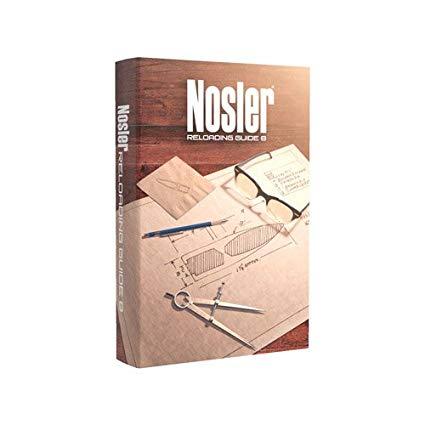
Reloading Manual
from $65.00*
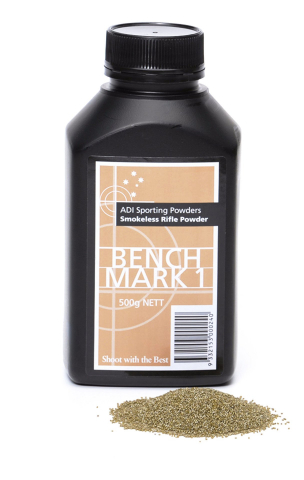
Gun Powder
Varies greatly^
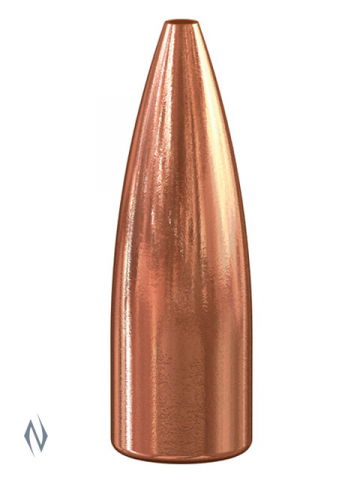
Bullets (projectiles)
Varies greatly
*Check out the Trophy Room for 10% OFF at Mansfield Hunting & Fishing
^powder cannot be purchased online
It’s very hard to reload more than one or two calibers (and also to experiment with different loads) without a reliable reloading manual. This includes all of the information you will need to help you decide on the type of powder, amount of powder and weight of projectile.
The combinations are endless but getting yourself one of these manuals will give you a great starting point using loads that have been tested by professionals.
Your manual will help to give you an idea of what powder and projectile weight to start with. Tailoring your round to the hunting that you are doing will be the focus of Part 3 (coming soon) of this series on reloading.
Some things to keep in mind:
- The combination of caliber, rifle, powder (type and amount), and projectile is what determines the accuracy of your round. One of the greatest benefits and challenges of reloading is that it can require a lot of experimenting. Start simple by using a projectile weight (e.g. 120gr) that matches a factory load you know shoots well in your rifle. Tweak from there depending on how your rifle reacts.
- For your projectiles, you want to use something that is tailored to the type of hunting you will be doing. For example, for pest control with smaller bodied animals like possums, kangaroos (with the correct permits), rabbits, foxes etc., a lighter projectile with a hollow point will mushroom and provide the best stopping power. Alternatively, for hunting large bodied, thick skinned animals like water buffalo, you want a heavy projectile travelling at high speed for maximum penetration.
- Generally speaking, your powder/projectile combination is about balancing the weight of the bullet with the speed that it travels to ensure maximum accuracy and also to deliver the desired effect at the point of impact. As with anything, this can take some trial and error to perfect but reloading your own ammunition gives you full control over those variables.
Case Cleaners
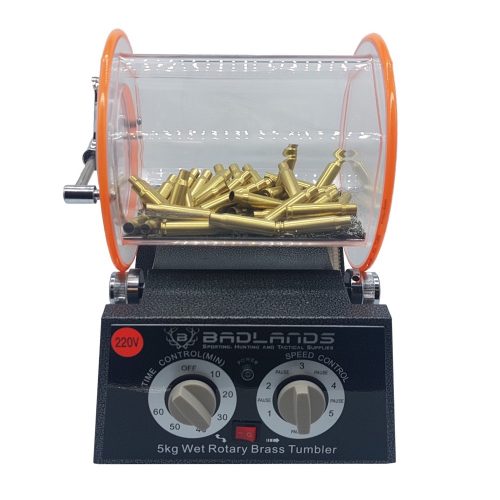
Rotary Tumbler
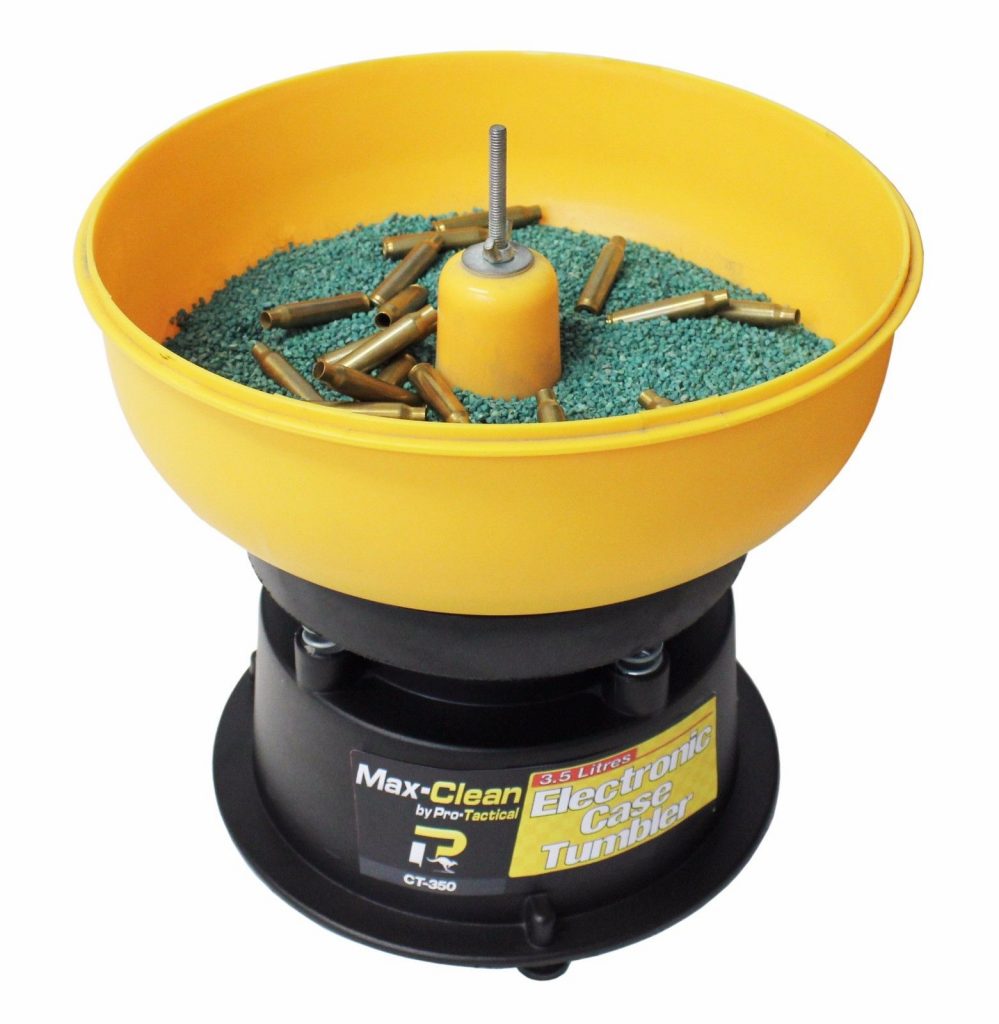
Pro-Tactical Case Tumbler
You can click on any of the pictures to visit the eBay listing for that item and purchase it for yourself.
When a round is fired, the primer explodes which ignites the gunpowder. This creates immense pressure that then pushes the bullet out of the barrel of your rifle. The process, while effective, is a dirty one and your case is left covered with fine layer of gunpowder residue.
A case tumbler uses either a wet (e.g. the Rotary Tumbler – left) or a dry (e.g. Pro-Tactical Tumbler – right) medium to clean and polish the cases ready for reloading.
Both work well, but we personally prefer the wet medium rotary tumbler (uses small steel rods, water, vinegar, citric acid and detergent to clean the cases).
The dry medium in the barrel-type case tumblers tends to leave its own residue on the cases and also doesn’t clean the primer seating. This creates an extra step that is all but eliminated by using the wet tumbler.
Reloading presses
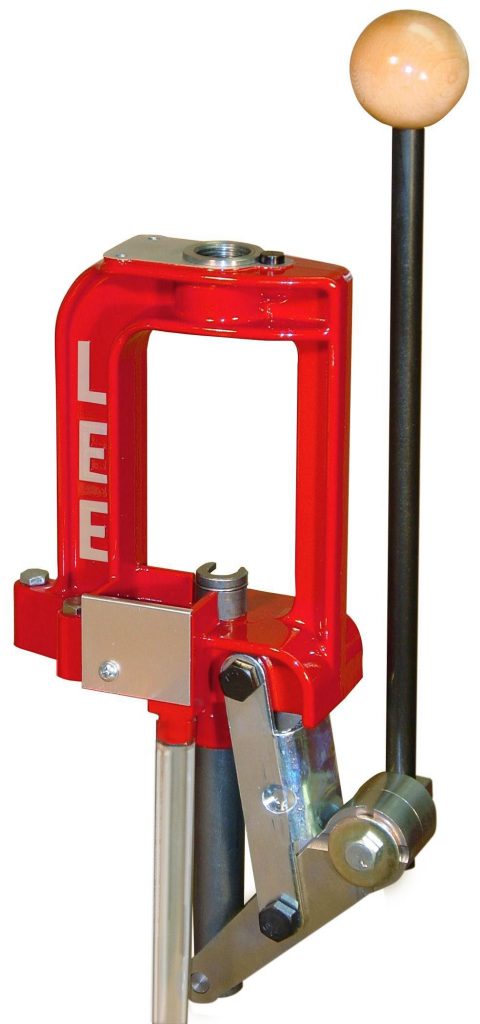
Lee Breech Lock Challenger Press
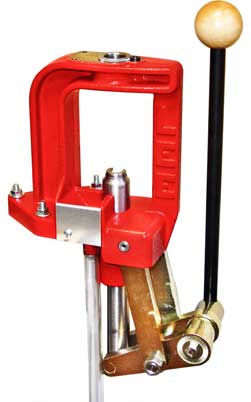
Lee Breech Lock Classic Cast
You can click on any of the pictures to visit the eBay listing for that item and purchase it for yourself.
The primary purpose of a press is to first remove the primer and resize the neck of the bullet (this will have stretched with the pressure created from being fired), and then to seat the new bullet in the final step of the reloading process. The press does this using a set of dies that is specific to your caliber. By purchasing the caliber-specific dies you need, one press will reload most rifle rounds.
Broadly speaking, there are two different types of reloading presses – single stage and turret. The single stage press (shown in both the suggestions above) is a great place to start and should satisfy the needs of most reloaders. The main benefit of a turret-style press is that it allows you to have multiple dies installed at once to streamline the reloading process. This is great if you are planning to reload large quantities of ammunition.
Reloading dies
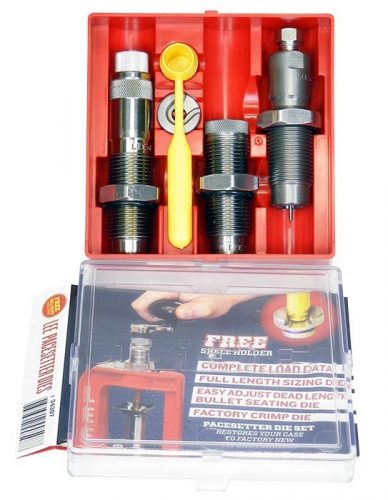
Lee PaceSetter 3-Die Set
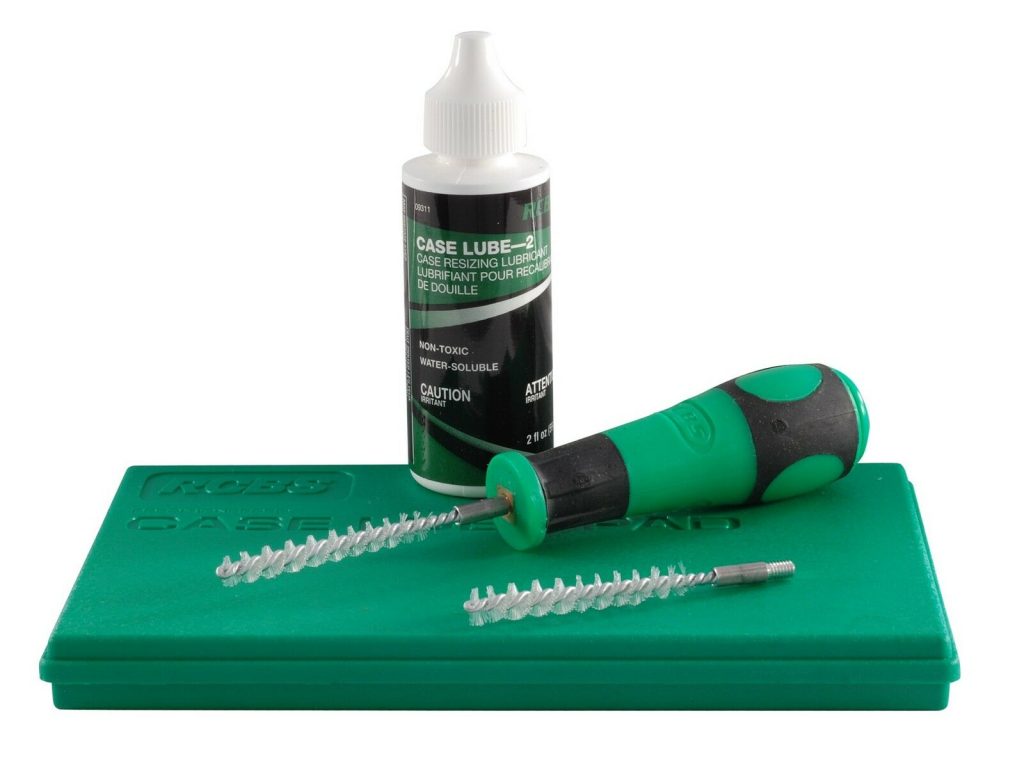
RCBS Case Lube Kit
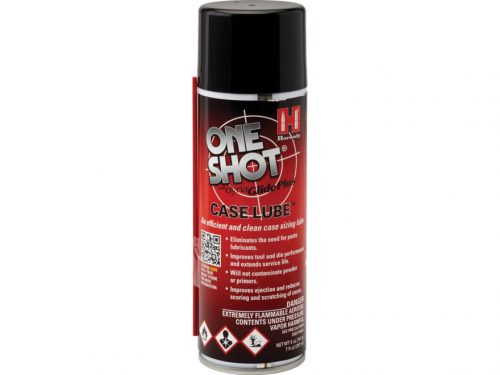
Hornady One Shot Case Lube
You can click on any of the pictures to visit the eBay listing for that item and purchase it for yourself.
As mentioned above, reloading dies are used along with your press (they screw into the top of the press itself) to do a few things.
The essential functions they have are to resize the neck of the case, push the primer out of its seating (one die will do both of these things in one smooth motion), and then reseat a new bullet completing your reloaded round.
As an absolute minimum you will need two different dies to do those jobs (a resizing die and a bullet seating die). There are some extra ones that you can buy to fine tune your round. For example, the Lee PaceSetter 3-Die Set (above) includes a crimp die. This is a great tool for use on your finished round to improve its accuracy and dependability.
You’ll need a case lube to use when you are resizing your cases with the first die. There are different applicators for this. We have found the best combination to be a case lube kit like one of the ones above. They have a large foam or cloth pad that you pour a small amount of the case lube onto, and then roll the case along. This gives an even coating without covering the case and everything else with case lube (like some of the sprays tend to do).

Re-sizing die

Bullet seating die

Crimp die
Other tools you'll need
One thing you should not cut corners with is your powder measure and your scale. These are the two things that ensure you have a correct and consistent amount of gunpowder in your rounds. There is nothing more frustrating than setting your powder measure to the amount that you want only to have it throw every second or third load – trust me!
Similarly, with your scale, you want something that is going to be reliable and consistent. When measuring out gunpowder, you’re dealing in precision so your scale needs to be able to handle those minute differences.
The case prep tool is necessary for cleaning out and deburring the primer seating and case neck. You can get anything from the manual tool that we included above to an (almost) fully automated, precision case prep station. This really just comes down to personal preference. I would suggest starting on the cheaper end with a manual tool and working your way up as you do more reloading.
Depending on the type of reloading press you buy, you may also need a priming tool. The Lee Breech Lock Classic Cast (above) has a built in priming arm, however the cheaper Challenger Press does not. With some presses, you can buy an add-on priming tool. Alternatively, you can purchase a hand priming tool like the Lyman one included above.
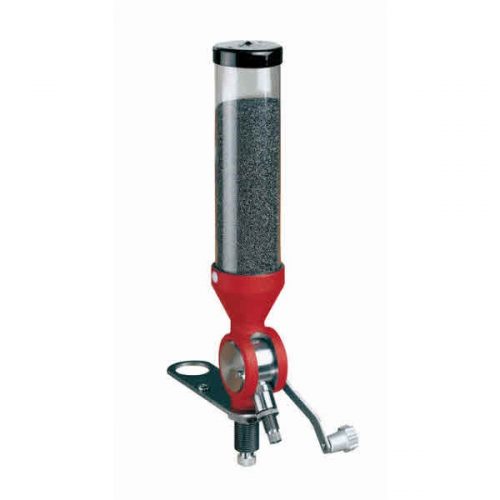
Hornady Powder Measure

Lyman Case Prep Multi-Tool
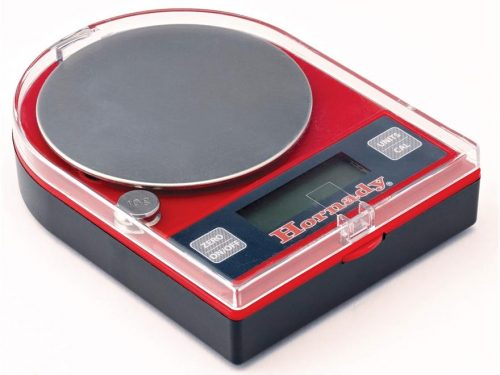
Hornady Electronic Scale
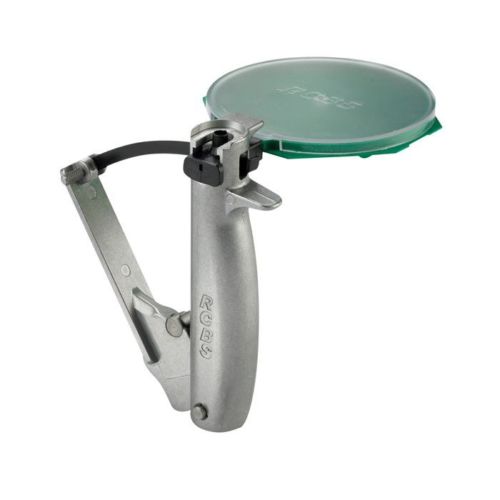
RCBS Priming Tool
You can click on any of the pictures to visit the eBay listing for that item and purchase it for yourself.
Helpful extras
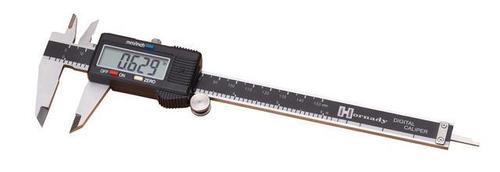
Hornady Digital Calipers
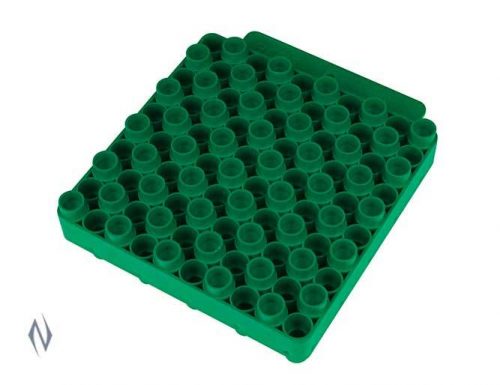
RCBS Universal Case Block

RCBS Bullet Puller
You can click on any of the pictures to visit the eBay listing for that item and purchase it for yourself.
Reloading kits
You might be sitting there wondering how on earth you are going to afford all of this. Reloading does save you money in the long run, but it is a bit of an investment up front.
While it is nice to be able to cherry pick the best options from the different brands, a cheaper alternative is to purchase a pre-packaged kit. This will have a lot of the basics that you need and you can then add to it/upgrade from there.
Here are a few good starter packs:
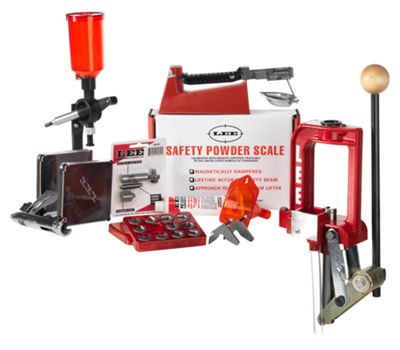
Lee Breech Lock Challenger Press Kit
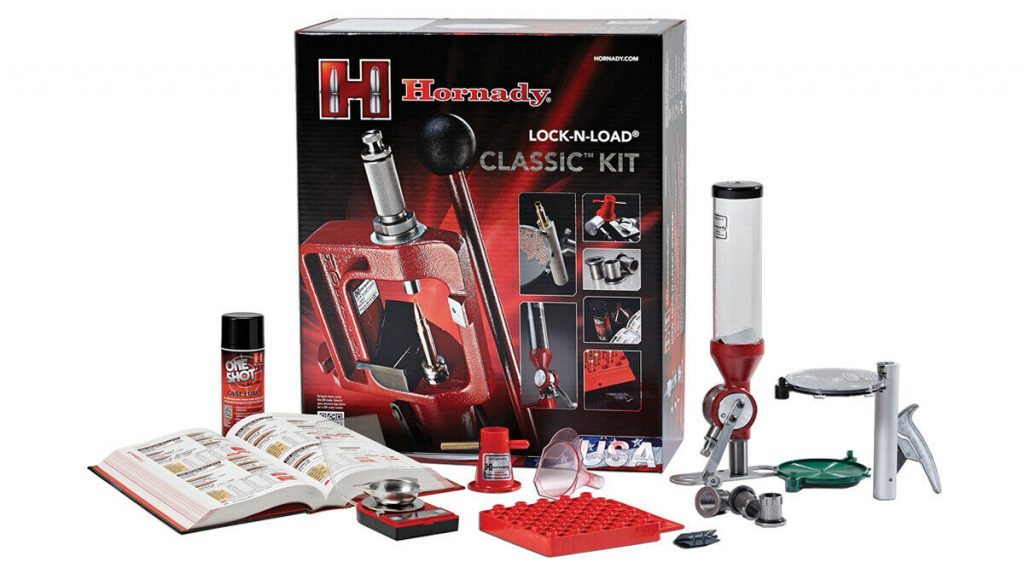
Hornady Lock-N-Load Classic Kit
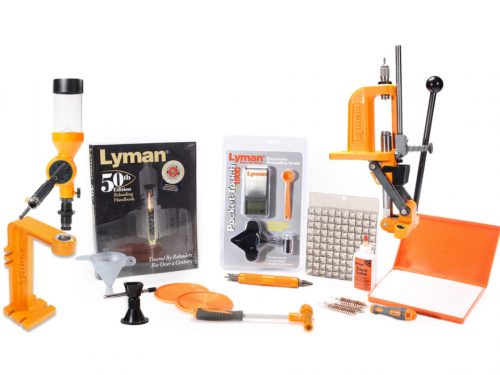
Lyman Brass Smith Victory Press Reloading Kit
You can click on any of the pictures to visit the eBay listing for that item and purchase it for yourself.
What is I Am Hunter?
I Am Hunter wants to change the way hunting is perceived and to change the conversation from a negative one driven by anti-hunters to a positive one led by hunters.
Our goal is to help hunters become positive role models and ambassadors for hunting, while simultaneously helping non-hunters understand why hunting is important.
You can become a supporter and help us achieve our goal and spread a positive message about hunting with the wider community.
Related content
If you would like to know more about hunting wallabies, kangaroos or deer in Tasmania, check out these related articles and podcasts.
Our other channels
Follow us on Facebook
Follow us on Instagram
YouTube
Subscribe to our YouTube channel.
Get our newsletter
Get our free monthly newsletter direct to your inbox
Listen on iTunes
Listen to our podcast on iTunes.
TV series
Watch I Am Hunter episodes on My Outdoor TV (MOTV)


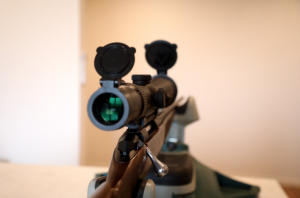





3 thoughts on “What you need to reload your own ammunition”